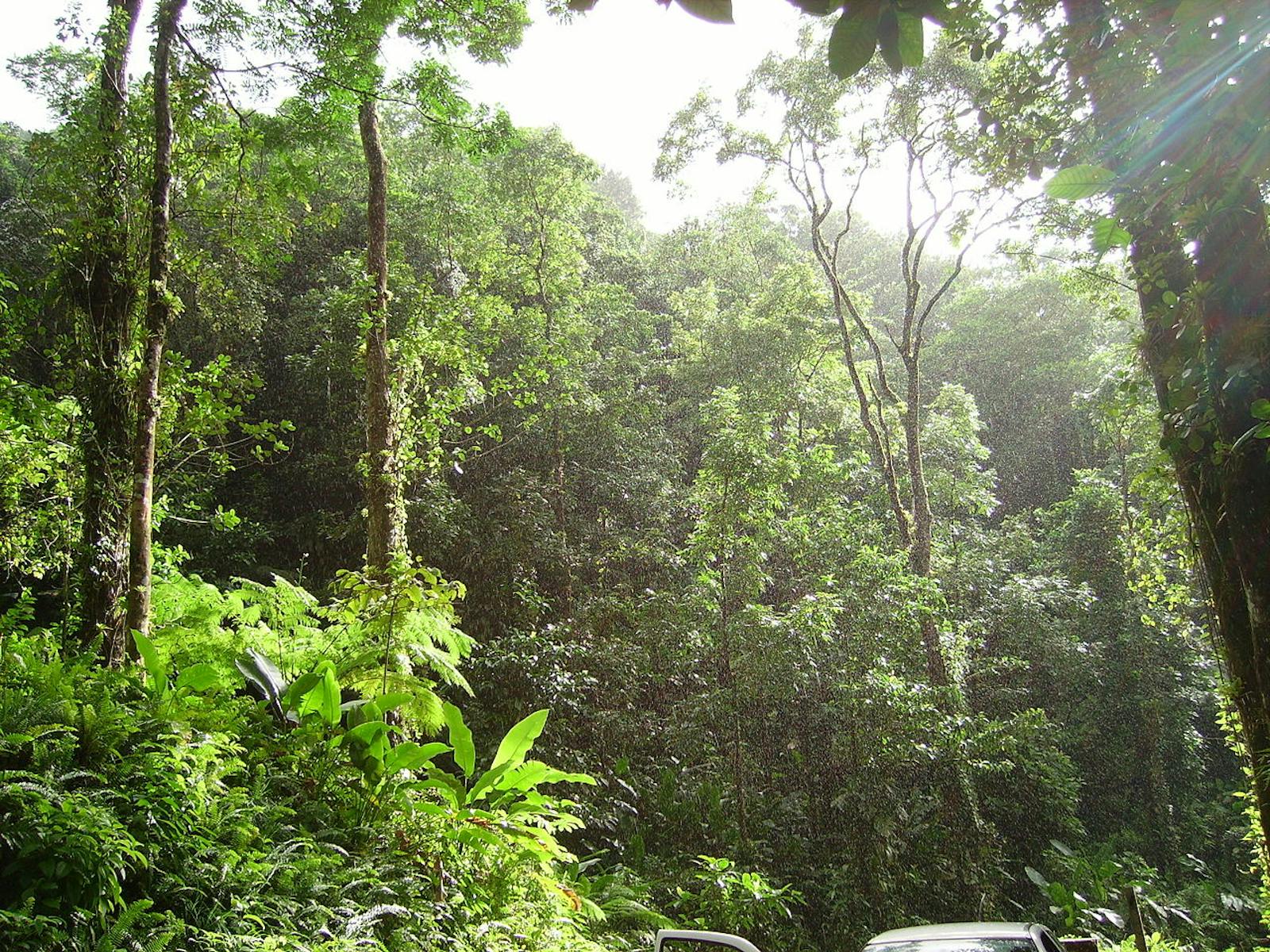Windward Islands Moist Forests
The ecoregion’s land area is provided in units of 1,000 hectares. The protection goal is the Global Safety Net (GSN1) area for the given ecoregion. The protection level indicates the percentage of the GSN goal that is currently protected on a scale of 0-10.
Bioregion: Caribbean Islands (NT26)
Realm: Central America
Ecoregion Size (1000 ha):
203
Ecoregion ID:
517
Conservation Target:
100%
Protection Level:
4
States: France, Dominica, Saint Lucia, Grenada, Saint Vincent and the Grenadines
The critically endangered giant ditch frog, also referred to as the “mountain chicken,” can be found on the islands of Dominica and Monserrat within the Windward Island Moist Forest ecoregion. Although it prefers primarily forest habitat, the frog can be found in secondary growth forests and plantations and has been observed eating a range of life food from insects, bats, snakes, and to other frogs. As its nickname suggests, the giant ditch frog is considered a delicacy on the island and has been unsustainably harvested in the 1990s. This, compounded with huge loss of habitat, the deadly infectious chytrid fungus disease, and volcanic eruption, further push this species to the brink of extinction.
.JPG)
The flagship species of the Windward Islands Moist Forests ecoregion is the giant ditch frog. Image credit: Courtesy of Zoochat
The Windward Island Moist Forests ecoregion is found in much of the central portion of each of the Caribbean’s Windward Islands and is characterized by rugged mountains, lush tropical vegetation, and high annual rainfall. The rugged topography of these islands contributes strongly to micro-climatic variability within short distances and serves to capture a great deal of the moisture contained within the air masses that enter the region from the Atlantic. Annual rainfall in the interior highlands ranges from 3,750 mm in the lower-elevation mountains in Grenada to 10,000 mm in Dominica.
Much of the mature moist forest in this ecoregion is an association of candlewood tree, Sloanea spp., and Amanoa caribaea. Secondary rain forests, i.e., areas previously occupied by mature rain forest that have experienced disturbance, primarily logging and shifting agriculture, are characterized by Miconia mirabilis, Cecropia schreberiana, and Smaruba amara.
Few other areas of comparable size in the world are endowed with a botanical heritage as diverse and interesting as the flora in this ecoregion. The five main Windward Islands boast nearly 168 regionally-endemic tree species. The vegetation comprises over one thousand species of flowering plants with about sixty woody plant and tree species per hectare.
This ecoregion is similarly high in faunal richness and diversity. Dominica supports over 50 species of resident birds, including two endemic parrots that are both threatened. In total the Windward Islands Moist Forest ecoregion supports 13 endemic species of birds. They also host 12 endemic species of amphibians and reptile. There are no island-endemic mammals in this ecoregion. All extant mammal species were introduced by Amerindian or colonial settlers, and include mongoose, agouti, opossum, and pig. Bats are common native species to the ecoregion, but none are endemic to the ecoregion.
The biologically rich forests of this ecoregion have drawn much conservation attention and consequently several important protected areas exist. Dominica still has large undisturbed montane forests that are regionally significant but inadequately protected. Martinique has some of the Caribbean’s largest forest tracks though much is secondary. Martinique has been subject to the same legislation as metropolitan France since 1953, producing a lot of conservation involvement at the local level by French NGOs.
A national park system on St. Vincent has been considered but is not fully approved or implemented. St. Vincent’s forests are being threatened by encroaching agriculture even though all forests above 305 m are theoretically protected by legislation. Although Grenada has one established protected area, there is no substantive national park legislation that provides adequate authority to establish or manage them.
Except for remote, inaccessible areas characterized by high relief, much of the forests on different islands suffer from similar human-related pressures, i.e., agricultural encroachment, hunting, and limited enforcement of wildlife and environmental legislation. An improved infrastructure of roads on most of the Windward Islands has allowed greater access to previously undisturbed forests and accelerated conversion of primary forest to agricultural plantations.
The priority conservation actions for the next decade will be to: 1) develop management mechanisms to regulate agricultural spread into natural habitat; 2) increase the capacity of the protected areas to enforce laws; and 3) encourage and supplement local education on more sustainable farming and resource collection practices.
Citations
1. Armstrong, S. 2019. Southern Caribbean: Islands of Martinique, Dominica, Grenada, Saint Lucia, Saint Vincent and the Grenadines. https://www.worldwildlife.org/ecoregions/nt0179 Accessed May 15, 2019.
2. Johnson, T. H. 1988. Biodiversity and conservation in the Caribbean: profiles of selected islands. International Council for Bird Preservation, Monograph No. 1., Cambridge UK.
3. Carrington, S. 1998. Wild plants of the eastern Caribbean. London: Macmillan Education LTD.



